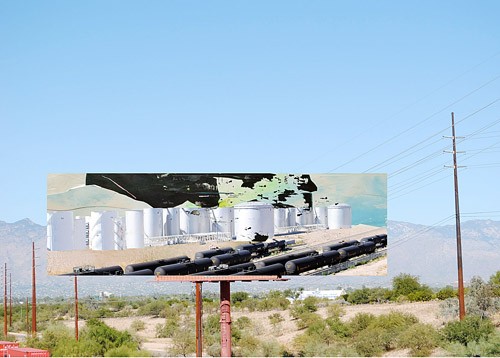This week, Master of Fine Arts candidate Andrea Jensen is making one of the ultimate signs of mass consumerism into a thought-provoking artistic medium. She has created a large-scale billboard installation at Alvernon Way and Ajo Way.
Jensen’s billboard is an impressive 14 by 48 feet and has been a project of hers for several months.
“”This (project) started as a response to the oil spill this summer. (The spill was) an example of the way that we’re using our land … and how that’s affecting our landscape,”” Jensen said.
The billboard is Jensen’s first large-scale installation, as well as her first opportunity to put her artwork out into the environment. It is a part of her thesis project.
She has also created a series of three paintings that complement the installation. These abstract collages of paint and recycled billboard materials are also a response to the BP oil spill. “”They’ll be more about my (emotions) about the oil spill when it happened — I felt very negative about it,”” Jensen said. The paintings are a series that begin with destruction and progress toward feelings of hope. Her paintings show that “”no matter how much we try to control nature, it will ultimately prevail,”” Jensen said.
Jensen integrated one of the images from her paintings into the billboard itself. Jensen explained that in this way, her artwork mirrors the process of recycling.
Although Jensen’s work places emphasis on environmental issues, she said that her main goal is to ask viewers to have a moment of reflection. Her artwork also reminds viewers of the environment itself, because the billboard features photos of the landscape that surrounds it.
“”I really just want viewers … to just think about how we’re using the land and how our lifestyle impacts that use,”” Jensen said.
Where did your idea to do this kind of work come from?
A lot of my work is in response to the landscape, our abuse of the landscape and environmental concerns. So I look at billboards as being part of this disruption, obscuring our view of the landscape. Billboards just remind us of things that we need to buy or things that we need to do. They take our attention away from what’s going on on the land or how we’re using it. They’re kind of a reflection of our fast-paced lifestyle. I’m interested in how that kind of lifestyle affects our landscape and leads to certain environmental issues.
How s location significant to your artwork?
I think it’s important in this case because … it’s actually in the presence of what I’m speaking of. I feel like the (location and the billboard itself) complement each other. When people go into the museum, they’re expecting to see art, but when you’re out on the highway and you’re passing a billboard, you’re not expecting it to be there. And I want there to be a link between the two. Also, I think it’ll touch a different audience — not everybody gets a chance to go see art in a gallery or museum. But a billboard is very much in the public sphere, so there will be a lot more people that will eventually see it.
Your artwork is really different from the advertisements that we would normally see on a billboard. Do you deliberately choose to make your message as different as possible from what people expect?
I see the billboard as a venue to draw attention to the landscape. The image on my billboard mirrors the landscape that’s just below it. So rather than have a message … or some advertisement on the billboard, it’s just going to reflect the surroundings. So I definitely hope that stands out as something different. I mean, some people don’t even notice billboards. They’ve just been ingrained into our minds. We’re so accustomed to seeing them — my hope is that maybe this will grab some attention because it’s the opposite of that.









